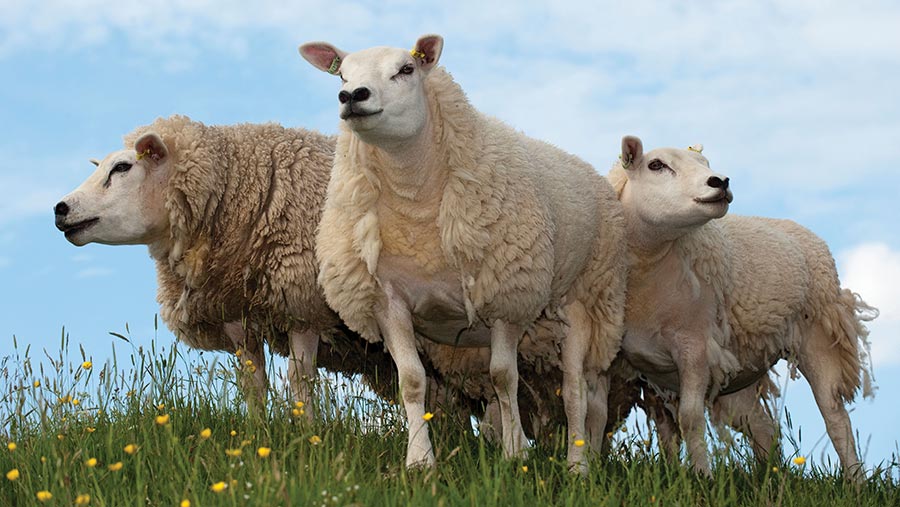Measuring carbon footprint vital to farmers’ competitiveness
 © Wayne Hutchinson/Alamy Stock Photo
© Wayne Hutchinson/Alamy Stock Photo Carbon emissions will act as a “licence to operate” in the future and farmers must measure their own carbon footprint to identify where they can make reductions.
This was the message from Rachael Madeley-Davies, head of sustainability and future policy at Hybu Cig Cymru.
She said Welsh sheep farmers were starting from a good place, with studies by Bangor University revealing Welsh lamb has one of the lowest carbon footprints globally at 10-13kg carbon dioxide equivalent (CO2e).
See also: Chambers deployed to measure methane emissions from sheep
However, she warned farmers could not afford to become complacent.
“We can’t take our eye off the ball. Our competitors are catching up with us. As farmers, we are absolutely part of the solution; we must grab it with two hands or someone else will,” she said.
“It is key that you measure your carbon footprint because, if you don’t measure it, you can’t manage it. [Carbon footprint] tools are not perfect, but it is about starting somewhere and identifying where you can make improvements.”
Reducing emissions using genetics
Dr Janet Roden, geneticist for Innovis, said the sheep of the future would need to be efficient so farmers produced less methane for every kilogram of meat.
She said genetics held the key to unlocking much of this potential, alongside good animal health, which was fundamental to animals channelling energy into growth, rather than fighting disease.
“Genetics can deliver cost-effective, permanent ways to reduce methane emissions. Of course, we want those sheep to be profitable and easy to manage, and therefore, attractive to keep,” she added.
The UK currently lags behind New Zealand, Australia, France and Ireland, which are already using methane-recording equipment to integrate greenhouse gas emission reductions into sheep breeding programmes.
However, this is set to change. Scotland’s Rural College has recently developed trailer-mounted chambers to monitor methane, which are being trialled in Hertfordshire.
Janet said the technology had “real potential for the future” and pointed to studies carried out by farm research scientist Suzanne Rowe in New Zealand that found a 10-12% difference in methane emissions between genetic lines.
In the meantime, she said there were already ways to improve production efficiencies, such as breeding ewe lambs.
This was not only a win-win for carbon footprint, but also for profitability, she added.
She said key breeding traits that could help reduce emissions were lambs reared a ewe, ewe longevity and days to target weight, alongside improved sheep health (see “Traits to reduce sheep emissions”).
However, these improvements must be made without increasing ewe size.
“If we increase ewe size, they eat more, cost more and emit more methane, so we can undo all the hard work,” she warned, adding that in lowland flocks, studies have shown the optimum ewe weight is 65kg.
“I believe sheep are part of our net-zero solution, but it needs a holistic approach where we understand the relationship with other traits,” said Janet.
Traits to reduce emissions
- Lambs reared a ewe Each lamb lost is methane being emitted into the atmosphere with no product to sell. Breed for better lamb survivability to improve this
- Ewe longevity The longer ewes can produce lambs, the more efficient production becomes. Farmers should decide when ewes leave the flock, not the other way round
- Days to target weight Lambs reaching slaughter quicker produce less methane over their lifetime compared with those that grow slower
- Health Parasitic worms cause reductions in growth and can increase the amount of methane sheep produce by 33%. Using individual faecal egg counts and measuring serum IgA can help identify sheep more resistant to nematodes
Source: Janet Roden, geneticist at Innovis
Sector ‘at a juncture’
Prysor Williams, senior lecturer in environmental management at Bangor University, said the sheep sector was at a juncture – did farmers increase productivity, go down the environmental route or take a hybrid approach?
Nicky Naylor, lecturer at Harper Adams University, suggested farmers could do both and should look at the benefits environmental schemes could bring to their businesses.
“We must not look at planting trees as problematic. They provide a valuable resource for farms. By providing shelter belts, we can reduce lamb losses by up to 30% and increase daily liveweight gains by 10-21%,” she said.
But she added that mental health was an important, yet often forgotten part of the conversation when it came to sustainability.
“We must maximise food production through efficiency and get better at what we are doing. However, we must balance that with landscape biodiversity and really focus on managing farmer health and welfare. Because if we don’t have farmers, we won’t have farms.”
Rachael Madeley-Davies, Janet Roden, Prysor Williams and Nicky Naylor were speaking at the NSA Welsh Sheep event, hosted by Hugh, Sioned and Dafydd Owen at Red House Farm, near Newtown in Powys, on 16 May
